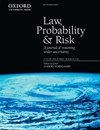Statistical Analyses in the case of an Italian nurse accused of murdering patients
IF 1.4
4区 社会学
Q1 LAW
引用次数: 2
Abstract
Suspicions about medical murder sometimes arise due to a surprising or unexpected series of events, such as an apparently unusual number of deaths among patients under the care of a particular nurse. But also a single disturbing event might trigger suspicion about a particular nurse, and this might then lead to investigation of events which happened when she was thought to be present. In either case, there is a statistical challenge of distinguishing event clusters that arise from criminal acts from those that arise coincidentally from other causes. We show that an apparently striking association between a nurse’s presence and a high rate of deaths in a hospital ward can easily be completely spurious. In short: in a medium-care hospital ward where many patients are suffering terminal illnesses, and deaths are frequent, most deaths occur in the morning. Most nurses are on duty in the morning, too. There are less deaths in the afternoon, and even less at night; correspondingly, less nurses are on duty in the afternoon, even less during the night. Consequently, a full time nurse works the most hours when the most deaths occur. The death rate is higher when she is present than when she is absent.意大利护士被控谋杀病人一案的统计分析
对医疗谋杀的怀疑有时是由于一系列令人惊讶或意想不到的事件引起的,例如在某一护士护理下的病人中出现明显不寻常的死亡人数。但一个令人不安的事件也可能引发对特定护士的怀疑,这可能会导致对她被认为在场时发生的事件的调查。在任何一种情况下,都存在一个统计上的挑战,即区分由犯罪行为引起的事件群与由其他原因巧合引起的事件群。我们表明,护士的存在与医院病房的高死亡率之间明显的惊人联系很容易完全虚假。简而言之:在医院的中等护理病房里,许多病人患有绝症,死亡很频繁,大多数死亡发生在早上。大多数护士在早上也值班。下午死亡人数较少,晚上死亡人数更少;相应地,下午值班的护士更少,晚上值班的护士更少。因此,全职护士工作时间最长,死亡人数最多。她在场时死亡率比她不在场时高。
本文章由计算机程序翻译,如有差异,请以英文原文为准。
求助全文
约1分钟内获得全文
求助全文
来源期刊

Law Probability & Risk
MATHEMATICSSTATISTICS & PROBABILITY&-STATISTICS & PROBABILITY
CiteScore
2.10
自引率
28.60%
发文量
8
期刊介绍:
Law, Probability & Risk is a fully refereed journal which publishes papers dealing with topics on the interface of law and probabilistic reasoning. These are interpreted broadly to include aspects relevant to the interpretation of scientific evidence, the assessment of uncertainty and the assessment of risk. The readership includes academic lawyers, mathematicians, statisticians and social scientists with interests in quantitative reasoning.
The primary objective of the journal is to cover issues in law, which have a scientific element, with an emphasis on statistical and probabilistic issues and the assessment of risk.
Examples of topics which may be covered include communications law, computers and the law, environmental law, law and medicine, regulatory law for science and technology, identification problems (such as DNA but including other materials), sampling issues (drugs, computer pornography, fraud), offender profiling, credit scoring, risk assessment, the role of statistics and probability in drafting legislation, the assessment of competing theories of evidence (possibly with a view to forming an optimal combination of them). In addition, a whole new area is emerging in the application of computers to medicine and other safety-critical areas. New legislation is required to define the responsibility of computer experts who develop software for tackling these safety-critical problems.
 求助内容:
求助内容: 应助结果提醒方式:
应助结果提醒方式:


